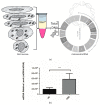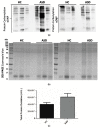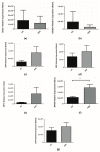Alterations of Mitochondrial Biology in the Oral Mucosa of Chilean Children with Autism Spectrum Disorder (ASD)
- PMID: 31018497
- PMCID: PMC6523430
- DOI: 10.3390/cells8040367
Alterations of Mitochondrial Biology in the Oral Mucosa of Chilean Children with Autism Spectrum Disorder (ASD)
Abstract
Autistic Spectrum Disorder (ASD) is characterized by the impairment of socio-communicative skills and the presence of restricted and stereotyped behavior patterns. Recent researches have revealed the influence of mitochondrial physiology on the development of ASD. Several research groups have identified defects in respiratory complexes, coenzyme-Q10 deficiency, increased oxidative damage, decreased of superoxide dismutase (SOD2). A study on the influence of mitochondrial physiology on the development of ASD can provide new alternatives and challenges. That is why we set ourselves the general objective to initiate studies of mitochondrial physiology in Chilean children with ASD. A sample of oral mucosa was collected in a group of 12 children diagnosed with ASD and 12 children without ASD. In children with ASD, we found a significant increase in mitochondrial DNA levels. Likewise, in these children, an increase in the protein oxidation was observed. Finally, a downward trend in the expression of the HIGD2A and SOD2 genes was observed, while DRP1, FIS1, MFN1, MFN2, and OPA1 gene expression show an upward trend. The increment of mitochondrial DNA, high oxidative stress, and high expression of the MFN2 gene could help as a scanner of the mitochondrial function in children with ASD.
Keywords: ASD; autism; gene expression; mitochondrial DNA; oral mucosa; oxidative stress.
Conflict of interest statement
The authors declare no conflict of interest.
Figures






Similar articles
-
Mitochondrial abnormalities in temporal lobe of autistic brain.Neurobiol Dis. 2013 Jun;54:349-61. doi: 10.1016/j.nbd.2013.01.006. Epub 2013 Jan 17. Neurobiol Dis. 2013. PMID: 23333625 Free PMC article.
-
Alterations of mitochondrial bioenergetics, dynamics, and morphology support the theory of oxidative damage involvement in autism spectrum disorder.FASEB J. 2020 May;34(5):6521-6538. doi: 10.1096/fj.201902677R. Epub 2020 Apr 4. FASEB J. 2020. PMID: 32246805
-
Predictive value of selected biomarkers related to metabolism and oxidative stress in children with autism spectrum disorder.Metab Brain Dis. 2017 Aug;32(4):1209-1221. doi: 10.1007/s11011-017-0029-x. Epub 2017 May 11. Metab Brain Dis. 2017. PMID: 28497358
-
Oxidative Stress in Autism Spectrum Disorder.Mol Neurobiol. 2020 May;57(5):2314-2332. doi: 10.1007/s12035-019-01742-2. Epub 2020 Feb 5. Mol Neurobiol. 2020. PMID: 32026227 Review.
-
Mitochondrial dysfunction in Autism Spectrum Disorder: clinical features and perspectives.Curr Opin Neurobiol. 2017 Aug;45:178-187. doi: 10.1016/j.conb.2017.05.018. Epub 2017 Jun 16. Curr Opin Neurobiol. 2017. PMID: 28628841 Review.
Cited by
-
Brain Opioid Activity and Oxidative Injury: Different Molecular Scenarios Connecting Celiac Disease and Autistic Spectrum Disorder.Brain Sci. 2020 Jul 9;10(7):437. doi: 10.3390/brainsci10070437. Brain Sci. 2020. PMID: 32659996 Free PMC article. Review.
-
Developmental Stage-Dependent Changes in Mitochondrial Function in the Brain of Offspring Following Prenatal Maternal Immune Activation.Int J Mol Sci. 2023 Apr 14;24(8):7243. doi: 10.3390/ijms24087243. Int J Mol Sci. 2023. PMID: 37108406 Free PMC article.
-
Mitochondrial DNA copy number in autism spectrum disorder and attention deficit hyperactivity disorder: a systematic review and meta-analysis.Front Psychiatry. 2023 Jul 5;14:1196035. doi: 10.3389/fpsyt.2023.1196035. eCollection 2023. Front Psychiatry. 2023. PMID: 37484684 Free PMC article. Review.
-
The Hepatic Mitochondrial Alterations Exacerbate Meta-Inflammation in Autism Spectrum Disorders.Antioxidants (Basel). 2022 Oct 7;11(10):1990. doi: 10.3390/antiox11101990. Antioxidants (Basel). 2022. PMID: 36290713 Free PMC article.
-
DNA Methylation of PGC-1α Is Associated With Elevated mtDNA Copy Number and Altered Urinary Metabolites in Autism Spectrum Disorder.Front Cell Dev Biol. 2021 Jul 26;9:696428. doi: 10.3389/fcell.2021.696428. eCollection 2021. Front Cell Dev Biol. 2021. PMID: 34381777 Free PMC article.
References
-
- Wing L. Diagnosis and Assessment in Autism. Springer; Boston, MA, USA: 1988. The continuum of autistic characteristics; pp. 91–110.
-
- Baird G., Simonoff E., Pickles A., Chandler S., Loucas T., Meldrum D., Charman T. Prevalence of disorders of the autism spectrum in a population cohort of children in South Thames: The Special Needs and Autism Project (SNAP) Lancet. 2006;368:210–215. doi: 10.1016/S0140-6736(06)69041-7. - DOI - PubMed
Publication types
MeSH terms
Substances
LinkOut - more resources
Full Text Sources
Medical
Miscellaneous

